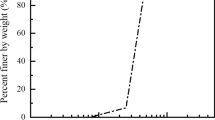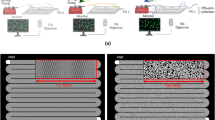Abstract
Microbially induced calcium carbonate (CaCO3) precipitation (MICP) has been extensively studied for soil improvement in geotechnical engineering. The quantity and size of calcium carbonate crystals affect the strength of MICP-treated soil. In this study, microfluidic chip experiments and soil column experiments were conducted to optimize MICP treatment protocols for effective strength enhancement of MICP-treated sandy soils. The microscale experiments reveal that, due to Ostwald ripening, longer injection intervals allow crystals to dissolve and reprecipitate into larger crystals regardless of the concentration of cementation solution. Even though a cementation solution input rate of 0.042 mol/l/h is sufficient to maintain a high chemical transformation efficiency, a further reduction in the input rate by about four times resulted in an increase in the size of crystals produced by the end of treatment from about 40 to 60 μm. These findings were applied in soil column experiments. Results showed that significantly larger crystals and higher soil strength were achieved when the normalized rate of cementation solution injection was reduced from 0.042 to 0.021 mol/l/h. Crystal size and soil strength increased slightly more when the normalized input rate was further reduced from 0.021 to 0.010 mol/l/h. This study demonstrates how data from microscale microfluidic experiments that examine the effects of injection intervals and concentration of cementation solution on the properties of calcium carbonate crystals can be used to optimize MICP treatment in macroscale sand soil column experiments for effective strength enhancement.















Similar content being viewed by others
References
ASTM (1986) D2938:390-391: Standard test method of unconfined compressive strength of intact rock core specimens. In: 1995 Annual Book of ASTM standards. ASTM, West Conshohocken, PA, USA.
ASTM (2004) D7012-14e1: Compressive strength and elastic moduli of intact rock core specimens under varying states of stress and temperatures. ASTM, West Conshohocken, PA, USA.
ASTM (2014) D4373–14: Standard test method for rapid determination of carbonate content of soils. ASTM, West Conshohocken, PA, USA.
Al Qabany A, Soga K (2013) Effect of chemical treatment used in MICP on engineering properties of cemented soils. Géotechnique 63(4):331–339
Al Qabany A, Soga K, Santamarina C (2012) Factors affecting efficiency of microbially induced calcite precipitation. J Geotech Geoenviron Eng 138(8):992–1001
Chen, Y., Gao, Y., Ng, C. W. W., & Guo, H. (2021). Bio-improved hydraulic properties of sand treated by soybean urease induced carbonate precipitation and its application Part 1: Water retention ability. Transp Geotech, 27(September 2020), 100489. https://doi.org/10.1016/j.trgeo.2020.100489
Chen, Y., Gao, Y., & Guo, H. (2021). Bio-improved hydraulic properties of sand treated by soybean urease induced carbonate precipitation and its application Part 2: Sand-geotextile capillary barrier effect. Transp Geotech 27(September 2020), 100484. https://doi.org/10.1016/j.trgeo.2020.100484
Cheng L, Cord-Ruwisch R (2012) In situ soil cementation with ureolytic bacteria by surface percolation. Ecol Eng 42:64–72
Cheng L, Shahin MA, Mujah D (2017) Influence of key environmental conditions on microbially induced cementation for soil stabilization. J Geotech Geoenviron Eng 143(1):04016083
Cui M-J, Zheng J-J, Zhang R-J, Lai H-J, Zhang J (2017) Influence of cementation level on the strength behaviour of bio-cemented sand. Acta Geotech 12(5):971–986
DeJong JT, Fritzges MB, Nüsslein K (2006) Microbially induced cementation to control sand response to undrained shear. J Geotech Geoenviron Eng 132(11):1381–1392
DeJong JT, Mortensen BM, Martinez BC, Nelson DC (2010) Bio-mediated soil improvement. Ecol Eng 36(2):197–210
DeJong JT, Soga K, Kavazanjian E, Burns S, Van Paassen LA, Al Qabany A, Aydilek A, Bang SS, Burbank M, Caslake LF, Chen CY, Cheng X, Chu J, Ciurli S, Esnault-Filet A, Fauriel S, Hamdan N, Hata T, Inagaki Y, Jefferis S, Kuo M, Laloui L, Larrahondo J, Manning DAC, Martinez B, Montoya BM, Nelson DC, Palomino A, Renforth P, Santamarina JC, Seagren EA, Tanyu B, Tsesarsky M, Weaver T (2013) Biogeochemical processes and geotechnical applications: progress, opportunities and challenges. Géotechnique 63(4):287–301
Dhami NK, Reddy MS, Mukherjee A (2013) Biomineralization of calcium carbonates and their engineered applications: a review. Front Microbiol 4(October):314
Gomez MG, Martinez BC, DeJong JT, Hunt CE, deVlaming L, A., Major, David W., Dworatzek, Sandra M, (2015) Field-scale bio-cementation tests to improve sands. Ground Improvement 168(3):206–216
Jiang NJ, Soga K, Kuo M (2017) Microbially induced carbonate precipitation for seepage-induced internal erosion control in sand-clay mixtures. J Geotech Geoenviron Eng 143(3):04016100
Kim D H, Mahabadi N, Jang J and van Paassen L A (2020). Assessing the kinetics and pore‐scale characteristics of biological calcium carbonate precipitation in porous media using a microfluidic chip experiment. Water Resour Res, 56, e2019WR025420.
Konstantinou C, Biscontin G (2021) Soil enhancement via microbially induced calcite precipitation. In: Geotechnical aspects of underground construction in soft ground. CRC Press, pp 765–772. https://doi.org/10.1201/9780429321559
Konstantinou C, Biscontin G, Jiang NJ, Soga K (2021) Application of microbially induced carbonate precipitation (MICP) to form bio-cemented artificial sandstone. J Rock Mech Geotech Eng. https://doi.org/10.1016/j.jrmge.2021.01.010
Konstantinou C, Wang Y, Biscontin G, Soga K (2021) The role of bacterial urease activity on the uniformity of carbonate precipitation profiles of bio-treated coarse sand specimens. Sci Rep 11:6161. https://doi.org/10.1038/s41598-021-85712-6
Konstantinou C, Biscontin G, Logothetis F (2021) Tensile strength of artificially cemented sandstone generated via microbially induced carbonate precipitation. Materials 14(16):4735. https://doi.org/10.3390/ma14164735
Lai HJ, Cui MJ, Wu SF, Yang Y, Chu J (2021) Retarding effect of concentration of cementation solution on biocementation of soil. Acta Geotech 16(5):1457–1472. https://doi.org/10.1007/s11440-021-01149-1
Lin H, Suleiman MT, Brown DG, Kavazanjian E Jr (2015) Mechanical behavior of sands treated by microbially induced carbonate precipitation. J Geotech Geoenviron Eng 142:04015066
Mahawish A, Bouazza A, Gates WP (2018) Improvement of coarse sand engineering properties by microbially induced calcite precipitation. Geomicrobiol J 35(10):887–897
Martinez BC, DeJong JT, Ginn TR, Montoya BM, Barkouki TH, Hunt C, Tanyu B, Major D (2013) Experimental optimization of microbial-induced carbonate precipitation for soil improvement. J Geotech Geoenviron Eng 139:587–598
Phillips AJ, Lauchnor E, Eldring J, Esposito R, Mitchell AC, Gerlach R, Spangler LH (2013) Potential CO2 leakage reduction through biofilm-induced calcium carbonate precipitation. Environ Sci Technol 47(1):142–149
Terzis D, Bernier-Latmani R, Laloui L (2016) Fabric characteristics and mechanical response of bio-improved sand to various treatment conditions. Géotech Lett 69(1):50–57
Terzis D, Laloui L (2018) 3-D micro-architecture and mechanical response of soil cemented via microbial-induced calcite precipitation. Sci Rep 8(1):1416
Terzis, Dimitrios and Laloui, Lyesse. 2019. A decade of progress and turning points in the understanding of bio-improved soils: a review. Geomech Energy Environ 19: 100116.
van Paassen L (2009) Biogrout: ground improvement by microbially induced carbonate precipitation. PhD Thesis, Delft University of Technology.
van Paassen L, Ghose R, van der Linden TJM, van der StarWRL and van Loosdrecht MCM, (2010) Quantifying biomediated ground improvement by ureolysis: large-scale biogrout experiment. J Geotech Geoenviron Eng 136(12):1721–1728
Wang Y, Soga K, DeJong JT, Kabla A (2019) A microfluidic chip and its use in characterizing the particle-scale behaviour of microbial-induced carbonate precipitation (MICP). Géotechnique 69(12):1086–1094
Wang Y, Soga K, DeJong JT, Kabla A (2019) Microscale visualization of microbial-induced carbonate precipitation (MICP) processes. J Geotech Geoenviron Eng 145(9):04019045
Wang Y, Soga K and Jiang NJ (2017) Microbial induced carbonate precipitation (MICP): the case for microscale perspective. In: Proceedings of the 19th international conference on soil mechanics and geotechnical engineering, 1099–1102.
Wang Y, Soga K, DeJong JT and Kabla A. (2021) Forthcoming. Effects of bacterial density on growth rate and characteristics of microbial-induced CaCO3 precipitates: a particle-scale experimental study. ASCE J Geotech Geoenviron Eng.https://doi.org/10.1016/(ASCE)GT.1943-5606.0002509
Weinhardt F, Class H, Vahid Dastjerdi S, Karadimitriou N, Lee D, Steeb H (2021) Experimental methods and imaging for enzymatically induced calcite precipitation in a microfluidic Cell. Water Resour Res 57(3):1–11. https://doi.org/10.1029/2020WR029361
Whiffin VS, van Paassen LA, Harkes MP (2007) Microbial carbonate precipitation as a soil improvementtechnique. Geomicrobiol J 24(5):417–423
Whitesides GM (2006) The origins and the future of microfluidics. Nature 442(7101):368–373
Xiao Y, He X, Wu W, Stuedlein AW, Evans TM, Chu J, Liu H, van Paassen LA, Wu H (2021) Kinetic biomineralization through microfluidic chip tests. Acta Geotech 16(10):3229–3237. https://doi.org/10.1007/s11440-021-01205-w
Zehner J, Røyne A, Sikorski P (2021) A sample cell for the study of enzyme-induced carbonate precipitation at the grain-scale and its implications for biocementation. Sci Rep 11(1):1–10. https://doi.org/10.1038/s41598-021-92235-7
Zehner J, Røyne A, Wentzel A, Sikorski P (2020) Microbial-induced calcium carbonate precipitation: an experimental toolbox forin situand real time investigation of micro-scale pH evolution. RSC Adv 10(35):20485–20493. https://doi.org/10.1039/d0ra03897k
Zhao Q, Li L, Li C, Li M, Amini F, Zhang H (2014) Factors affecting improvement of engineering properties of MICP-treated soil catalyzed by bacteria and urease. J Mater Civ Eng 26(12):04014094. https://doi.org/10.1061/(asce)mt.1943-5533.0001013
Zhou H, Xu S, Sun Z (2018) Real-time in situ observation of shear modulus evolution during Ostwald ripening of colloidal crystallization. J Cryst Growth 502(June):35–40
Acknowledgements
Y.W. acknowledges the support of the Natural Science Foundation of China (Grant Nos. 52171262, 42141003), Science and Technology Innovation Committee of Shenzhen (Grant No. JCYJ20210324103812033) and Southern Marine Science and Engineering Guangdong Laboratory (Guangzhou, Grant No. K19313901) for conducting this study. The authors would also like to acknowledge Dr. Fedir Kiskin for proofreading the manuscript.
Author information
Authors and Affiliations
Corresponding author
Additional information
Publisher's Note
Springer Nature remains neutral with regard to jurisdictional claims in published maps and institutional affiliations.
Rights and permissions
About this article
Cite this article
Wang, Y., Konstantinou, C., Soga, K. et al. Use of microfluidic experiments to optimize MICP treatment protocols for effective strength enhancement of MICP-treated sandy soils. Acta Geotech. 17, 3817–3838 (2022). https://doi.org/10.1007/s11440-022-01478-9
Received:
Accepted:
Published:
Issue Date:
DOI: https://doi.org/10.1007/s11440-022-01478-9




